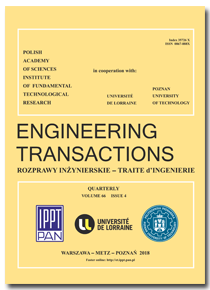10.24423/ENGTRANS.198.2008
Modelling of the electrohydraulic full active vehicle suspension
References
J. Bajkowski, W. Grzesikiewicz, L. Orłowski, Model matematyczny oraz badania eksperymentalne elementów zawieszenia szybkobieżnego pojazdu gąsienicowego, Zeszyty Naukowe P.P., Wyd. Polit. Poznańska, 54, 23–30, 2002.
D. A. Crolla, M. B. A. Abdel–Hady, Active suspension control; performance comparisons using control laws applied to a full vehicle model, Vehicle System Dynamics, 20, 107–120 1991.
M. D. Donahue, Implementation of an Active Suspension, Preview Controller for Improved Ride Comfort, University of California – Berkeley 2001.
J. Grajnert, Izolacja drgań w maszynach i pojazdach, Wydawnictwo Politechniki Wrocławskiej – Wrocław 1997, ISSN 1425-0993.
C. H. Hansen, S. D. Snyder, Active control of noise and vibration, E & FN SPON: Chapman and Hall, London 1997.
D. Hrovat, Survey of advanced suspension developments and related optimal control applications, Automatica, 33, 10, 1781–1817, 1997.
R. Johansson, A. Rantzer, Nonlinear and Hybrid systems in automotive control, Springer, 2003.
D. Karnopp, Vehicle stability, Marcel Dekker, New York 2004.
J. A. Levitt, N. G. Zorka, Influence of tire damping in quarter car active suspension models, Journal of Dynamic Systems, Measurement and Control: Transactions of the ASME, 113, 134–137, 1991.
R. Palej, Dynamika i stateczność aktywnych pneumatycznych układów wibroizolacji, Seria Mechanika – Monografia 218 Wydawnictwo Politechniki Krakowskiej, Kraków 1997, PL ISSN 0860-097X.
A. Pizoń, Hydrauliczne i elektrohydrauliczne układy sterowania i regulacji, WNT, Warszawa 1987.
J. Pluta, J. Konieczny, R. Korzeniowski, Badanie pneumatycznych układów redukcji drgań mechanicznych, PNEUMA’2000: XII Krajowa Konferencja Pneuma’ 2000 Kielce 2000, Wydawnictwo Politechniki Świętokrzystkiej – Zeszyty Naukowe Elektryka, 39, 269–278, PL ISSN 0239-4960.
R. Rajamani, Vehicle dynamics and control, Springer, 2006.
Mannesmann Rexroth Catalogue.
J. T. Viersma, Analysis, synthesis and design of hydraulics servosystems and pipelines, Amsterdam, Elsevier Scientific Publishing Company, 1980.
G. R. Wendel, G. L. Stecklein, A regenerative active suspension system. Vehicle Dynamics and Electronic Controlled Suspensions, SAE Special Publication Number 861, 129–135, 1991.
S. Yildirim, Vibration control of suspension using a proposed neural network, Journal of Sound and Vibration, 277, 1059–1069, 2004.
F. Yu, D. A. Crolla, An optimal self-tuning controller for an active suspension, Vehicle System Dynamics, 29, 51–65, 1998.
F. Yu, D. A. Crolla, State observer design for an adaptive vehicle suspension, Vehicle System Dynamics, 30, 457–471, 1998.
A. Zaremba, Optimal active suspension design using constrained optimization, Journal of Sound and Vibration, 207, 3, 351–364, 1997.
DOI: 10.24423/ENGTRANS.198.2008




